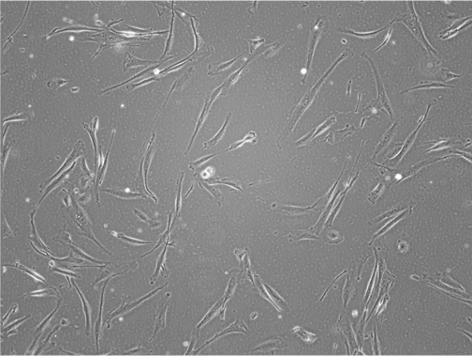Muscle
LHCN-M2
Evercyte’s human myoblast cell line LHCN-M2 can be grown without limitations while maintaining expression of cell type specific markers and function. Therefore, these cells are useful for screening substances influencing muscle contraction, to study myotoxicity or muscle damage. Additionally, the cell line is the perfect starting material for genetic engineering to create important disease models such as Duchenne muscular dystrophy or Facioscapulohumeral muscular dystrophy.
General information
Cat#: CkHT-040-231-2
Morphology and marker expression
LHCN-M2 cells are characterized by the typical, myoblast morphology.
The cells homogenously express CD56 as demonstrated by immunofluorescence staining.
Differentiation

Differentiation of LHCN-M2 cells leads to increased expression of typical myoblast markers desmin, MF-20 and Pax7 concomitant with fusion of cells and formation of myotubes.
FAQs
In vitro propagation
MyoUp ready-to use medium (Cat# MHT-040)
DMEM (Gibco, Cat # 61965-026) / M199 (Gibco, Cat# 31150022, 4+1
15 % Fetal bovine serum (PAN Biotech, Cat# P30-3031)
20 mM Hepes (Sigma-Aldrich, Cat# H0887)
3 µg/ml Zinc sulfate (Sigma-Aldrich, Cat# Z0251)
1.4 µg/ml Vitamin B12 (Sigma-Aldrich, Cat# V2876)
0.055 µg/ml Dexamethasone (Sigma-Aldrich, Cat# D4902)
2.5 ng/ml HGF (Merck Millipore, Cat# GF116)
5 ng/ml bFGF (Enantis, Cat# FGF-STAB)
Additional material & reagents
0,1 % Gelatin from porcine skin – Type A (Sigma-Aldrich, Cat# G1890, prepare in sterile water)
Phosphate buffered saline (PBS) (Gibco, Cat# 14190-144)
0,05 % Trypsin-EDTA (Gibco, Cat#25300-054)
Passaging of cells
The new culture flasks have to be pre-coated with porcine gelatin. Therefore, the culture flasks are treated with Gelatin solution (80 µl/cm²) at 37°C for at least 4 hours (up to one week).
Cryopreservation
Freezing medium
DMEM (Gibco, Cat # 61965-026) / M199 (Gibco, Cat# 31150022, 4+1
15 % Fetal bovine serum (PAN Biotech, Cat# P30-3031)
10 % DMSO (Sigma-Aldrich, Cat# D2650)
Additional material & reagents
0,1 % Gelatin from porcine skin – Type A (Sigma-Aldrich, Cat# G1890, prepare in sterile water)
Phosphate buffered saline (PBS) (Gibco, Cat# 14190-144)
0,05 % Trypsin-EDTA (Gibco, Cat#25300-054)
Freezing of cells
Detach the cells from the culture vessel by using Trypsin-EDTA solution (Protocol passaging of LHCN-M2).
Thawing of cells
Original Evercyte cells are to be thawed in a T75 roux flask
Product data sheet – certificate of analysis
Protocols
Data on Markers and Functions
Selected publications
Tan A, Younis AZ, Evans A, Creighton JV, Coveny C, Boocock DJ, Sale C, Lavery GG, Coutts AS, Doig CL. PARP1 mediated PARylation contributes to myogenic progression and glucocorticoid transcriptional response. Cell Death Discov. 2023 Apr 22;9(1):133. doi: 10.1038/s41420-023-01420-2.
Turner MC, Brett R, Saini A, Stewart CE, Renshaw D. Serum concentration impacts myosin heavy chain expression but not cellular respiration in human LHCN-M2 myoblasts undergoing differentiation. Exp Physiol. 2023 Feb;108(2):169-176. doi: 10.1113/EP090564.
García-Benlloch S, Revert-Ros F, Blesa JR, Alis R. MOTS-c promotes muscle differentiation in vitro. Peptides. 2022 Sep;155:170840. doi: 10.1016/j.peptides.2022.170840.
Gludovacz E, Schuetzenberger K, Resch M, Tillmann K, Petroczi K, Vondra S, Vakal S, Schosserer M, Virgolini N, Pollheimer J, Salminen TA, Jilma B, Borth N, Boehm T. Human diamine oxidase cellular binding and internalization in vitro and rapid clearance in vivo are not mediated by N-glycans but by heparan sulfate proteoglycan interactions. Glycobiology. 2021 May 3;31(4):444-458. doi: 10.1093/glycob/cwaa090. PMID: 32985651.
Maurer M, et al. (2015), IL-6 and Akt are involved in muscular pathogenesis in myasthenia gravis. Acta Neuropathol Commun. 2015 Jan 15;3:1. [PMID: 25627031] https://pubmed.ncbi.nlm.nih.gov/25627031/
Meyer S.U. et. al (2015), TNF-α and IGF1 modify the microRNA signature in skeletal muscle cell differentiation. Cell Commun Signal. 2015 Jan 29;13:4. [PMID: 25630602]https://pubmed.ncbi.nlm.nih.gov/25630602/
mechanism. Diabetologia. 2013 Jun;56(6):1372-82. [PMID: 23460021] https://pubmed.ncbi.nlm.nih.gov/23460021/
Licence Conditions
The business concept of Evercyte is to out-license telomerized cells to our customers. The license conditions depend on whether the contract partner is a for profit or a nonprofit organization and the intended use of the cells.
Nonprofit organizations
On time payment for unlimited use: EUR 1700
Profit organizations
Pharmaceutical – chemical- cosmetic industries
Contract research organizations (CRO)
Initial license fee for 3 months: EUR 2700Annual license fee R&D: royalty based
Customer Reviews
“I have had the pleasure of working with Evercyte for the last few years. We continually rely on Evercyte because of the high-quality data that they produce, their diligent responsiveness, and their excellent customer service.”
Josh Garlich, Senior Research Scientist, Apellis Pharmaceuticals, Inc.
“Cytonus has been working with Evercyte from many years as they are a trusted partner and have always delivered the highest quality cell lines to advance our platform. We routinely draw on their expertise to meet cellular engineering challenges and they have not disappointed.”
Remo Moomiaie-Qajar, Cytonus Therapeutics, Inc.
LHCN-M2

Customer Reviews
“I have had the pleasure of working with Evercyte for the last few years. We continually rely on Evercyte because of the high-quality data that they produce, their diligent responsiveness, and their excellent customer service.”
Josh Garlich, Senior Research Scientist, Apellis Pharmaceuticals, Inc.
“Cytonus has been working with Evercyte from many years as they are a trusted partner and have always delivered the highest quality cell lines to advance our platform. We routinely draw on their expertise to meet cellular engineering challenges and they have not disappointed.”
Remo Moomiaie-Qajar, Cytonus Therapeutics, Inc.



